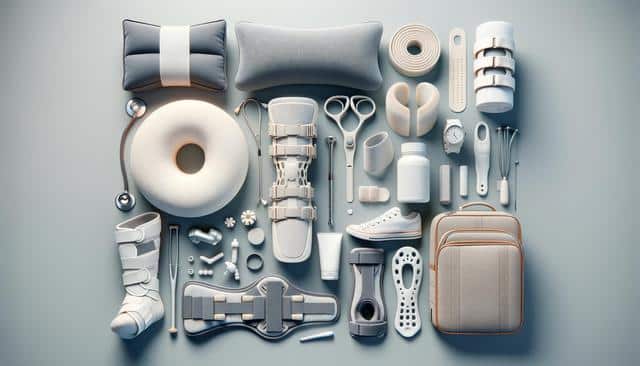
Orthopedic Supplies That Support Pain Relief: A Buyer’s Guide
Understanding the Role of Orthopedic Supplies in Pain Management
Orthopedic supplies are essential tools for individuals managing chronic pain, recovering from injuries, or dealing with mobility limitations. These products are designed to improve comfort, enhance mobility, and support the body’s natural healing processes. They are particularly beneficial for people with arthritis, joint pain, back issues, or post-operative recovery needs. While not substitutes for medical treatment, orthopedic aids offer valuable support in everyday life by reducing strain and promoting proper alignment. Understanding how these products work is the first step toward choosing the right one for your condition.
Orthopedic supplies come in various forms, each serving a specific purpose. Some of the most commonly used items include:
- Braces and supports for joints like knees, wrists, or ankles
- Foot orthotics for arch support and posture correction
- Mobility aids such as canes, walkers, and crutches
- Posture correctors and lumbar belts for spinal alignment
- Hot and cold therapy packs for inflammation control
By understanding the function of each item, users can select the most suitable products for their specific condition, leading to more effective pain relief and improved quality of life.
Braces and Supports: Targeted Relief for Joints
One of the most widely used orthopedic supplies are braces and supports. These devices are designed to stabilize and protect joints that are injured, weak, or recovering from surgery. They reduce movement that may aggravate pain and allow the affected area to heal more efficiently. Braces are available for nearly every joint in the body, including knees, ankles, wrists, elbows, and shoulders.
Users often select braces for conditions such as:
- Osteoarthritis
- Tendonitis
- Ligament injuries (such as ACL or MCL tears)
- Post-surgical recovery
- Repetitive strain injuries
The right brace should offer a balance between support and flexibility. Some models are designed for daily wear, while others are meant for sports or rehabilitation. Adjustable straps and breathable materials enhance comfort, making it easier to wear the brace for extended periods. Consulting with a healthcare provider can help ensure the correct fit and level of support for your needs.
Foot Orthotics and Insoles: Foundation for Pain-Free Movement
Foot pain can significantly impact daily activities, and orthopedic insoles or orthotics are often a simple yet effective solution. These inserts are placed inside footwear to provide additional arch support, correct posture, and reduce pressure on sensitive areas. They are especially useful for people with flat feet, plantar fasciitis, or heel spurs.
Orthotics help in several key ways:
- Distribute weight more evenly across the foot
- Improve gait and posture
- Reduce stress on knees, hips, and lower back
- Provide cushioning for shock absorption
Custom-made orthotics can be prescribed by podiatrists for more severe conditions, while over-the-counter options are also available for general support. When selecting insoles, it’s important to consider material (gel, foam, or plastic), arch height, and shoe compatibility to ensure optimal results. Regular use can greatly enhance comfort during walking or standing, particularly for individuals who spend long hours on their feet.
Mobility Aids: Regaining Independence and Reducing Strain
Mobility aids are indispensable for individuals with limited movement due to age, injury, or disability. These tools not only promote independence but also help reduce the physical strain on joints and muscles. Common mobility aids include canes, crutches, walkers, and rollators, each suited for different levels of support and mobility challenges.
Choosing the right mobility aid depends on factors such as balance, weight-bearing ability, and personal comfort. For example:
- Canes offer minimal support and are ideal for balance issues
- Crutches provide full support for one leg, often used post-injury
- Walkers deliver full-body support and are suitable for those with significant mobility limitations
- Rollators include wheels and a seat, combining stability with convenience
Proper sizing and adjustment are critical to ensure safety and comfort. Many models feature ergonomic handles, foldable designs, and height adjustability. Using mobility aids correctly can prevent falls, reduce pain from overexertion, and enable more active lifestyles despite physical limitations.
Posture and Back Support: Alleviating Spinal Strain
Back pain is one of the most common complaints addressed by orthopedic supplies. Posture correctors and lumbar supports help align the spine, reduce muscular strain, and prevent slouching. These products are particularly beneficial for people who spend extended periods sitting, such as office workers or drivers.
Common types of back supports include:
- Lumbar belts for lower back pain
- Posture braces for upper back and shoulder alignment
- Cushioned seat supports for improved sitting posture
Wearing a support device can encourage muscle memory for better posture, reducing long-term discomfort. However, it’s important to use these aids as part of a broader pain management strategy that may include exercise, stretching, or physical therapy. Overreliance on braces without strengthening exercises can lead to weakened muscles, so balance is key.
Look for features like adjustable tension, breathable materials, and easy-to-wear designs. Many users report improved comfort during daily tasks and reduced fatigue after using posture supports consistently.
Conclusion: Making Smart Choices for Pain Relief
Orthopedic supplies play a vital role in managing pain and promoting recovery. Whether you’re dealing with chronic joint issues, recovering from surgery, or seeking better posture, the right tools can make a measurable difference in your daily comfort and mobility. From braces and insoles to mobility aids and back supports, each product offers targeted benefits when used appropriately.
Before purchasing, assess your specific needs, consult a healthcare provider if necessary, and prioritize quality and fit. With informed choices, these orthopedic aids can support your journey toward reduced pain, increased mobility, and improved quality of life.


